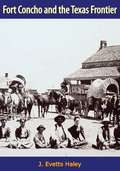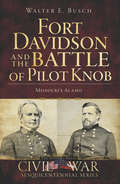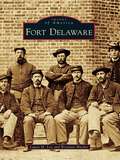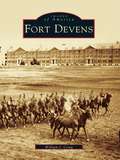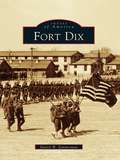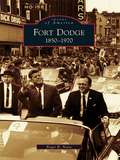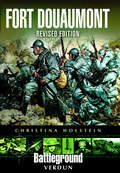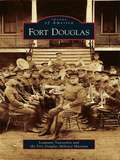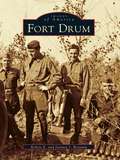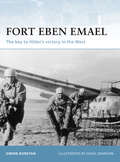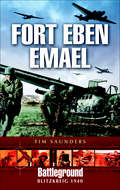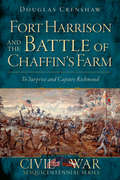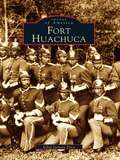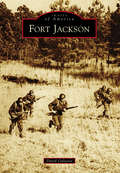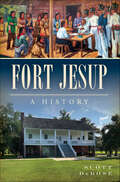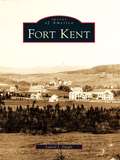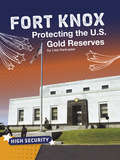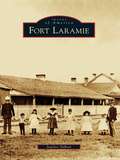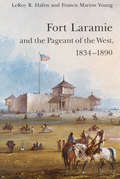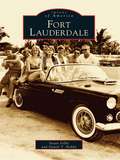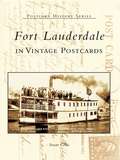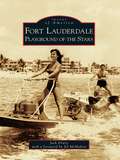- Table View
- List View
Fort Concho and the Texas Frontier
by J. Evetts HaleyThis book, which was first published in 1952, first began as a history of San Angelo and the adjacent region drained by the Conchos rivers. It grew, in writing, into a history of West Texas. It embodies author J. Evetts Haley’s unequaled knowledge of the country from the Rio Grande to the Canadian, from San Antonio and Austin to the border of New Mexico.It could have been written only by a man familiar by personal acquaintance with the location of every water hole and spring, the exploration of every trail from Coronado’s to the Overland Mail, the great cattle drives of the seventies and eighties, the establishment of every military post, and the shifting Indian policies of the United States from the annexation of Texas to the final retirement of the Comanches to the Indian Territory (now Oklahoma). Haley has an intimate knowledge of hundreds of salty characters who played their picturesque roles in transforming the land from nature to civilization.Haley possesses all this equipment—gained from intensive study, personal experience, and thoughtful reflection—for writing a vivid story. Five previous books and unnumbered articles on phases of the region contribute to the facility with which he tells this stirring tale and account of its comprehensiveness. It is no less than a history of West Texas in its heroic age.
Fort Davidson and the Battle of Pilot Knob: Missouri's Alamo
by Walter E. BuschLocal civilians and Civil War veterans felt a special connection to Fort Davidson long after the war. The survivors formed the Pilot Knob Memorial Association to ensure that the focal point of their battle, their glory and their Civil War would never be forgotten. Historian Walter Busch presents the association's records, along with Iron County court records, newspaper accounts and surviving photographs, to relate the history of the Battle of Pilot Knob and chronicle the diligent work to preserve Fort Davidson, now a state historic site.
Fort Delaware (Images of America)
by Brendan Mackie Laura M. LeeLocated on Pea Patch Island, Fort Delaware was erected to defend local ports from enemy attack but never received or fired a shot in anger. The first earthen-work version, constructed during the War of 1812, was followed by a second 1820s plan incorporating a masonry star design with a network of drainage ditches. Engineering issues and a low-lying site doomed the structure; in 1831, it was irreparably damaged by fire. A new plan created a more substantial fortification still standing to this day. Fort Delaware evolved into a well-established community that transformed from protector to notorious Civil War prison camp. Most widely known as a prison, it subsequently served in lesser roles through three more conflicts. Images of America: Fort Delaware unifies an amazing pictorial record of Fort Delaware's historical timeline. The story is not only of active duty but its rescue from abandonment and subsequent successful preservation work.
Fort Devens (Images of America)
by William J. CraigThe geographical location of Fort Devens has a military history that dates back to the 1600s, when the area was first garrisoned by British troops. In 1915, the region was again chosen for a cantonment, one of only sixteen in the country. In order to build the camp, the War Department assembled the largest labor force in history. New buildings sprang up at the rate of about ten per day and supported more than one hundred thousand troops that were processed at Camp Devens, as it was originally named, during World War I.Fort Devens is the first book to trace the military activity in this area. Throughout the twentieth century, troops were trained and deployed from Fort Devens for every major conflict the United States was involved in. During World War II, Fort Devens inducted more than six hundred thousand men into the army from the New England area. The list of individuals who have served here included Pulitzer Prize-winning cartoonist Bill Mauldin, Secretary of State Colin L. Powell, and Senator Edward M. Kennedy. Even NASA can trace its birth to Fort Devens by way of Dr. Robert Goddard's liquid-fueled rocket experiments.
Fort Dix (Images of America)
by Daniel W. ZimmermanLocated in central New Jersey, Fort Dix has been training soldiers since its founding in 1917. More than three million men and women have passed through its gates since it was built as one of the original sixteen army camps to train and mobilize soldiers for World War I. Using historical images, Fort Dix chronicles the history of life in an army camp from 1917 to the present. The fort, once known as Camp Dix, has experienced many changes over the years. This unprecedented photographic history traces the evolution from a wooden cantonment to the installation of brick and fiber optics, from a horse-dominated transportation system to a motor vehicle system, and from training recruits to serving Army Reserve and National Guard soldiers. Along the way, Fort Dix depicts the influence of the 78th Division, the Civilian Conservation Corps, the Women's Army Corps, Desert Storm, and the humanitarian work of resettling the Kosovo refugees.
Fort Dodge: 1850 to 1970
by Roger B. NatteFort Dodge was founded in 1850 as a military post to police the Iowa frontier. A subsequent land boom created fortunes that were reinvested in the local economy. The town soon earned the nickname "Mineral City" because of the extensive deposits of coal, gypsum, limestone, and clay. By 1900, the city was a rail center and the world's largest producer of gypsum products. With a highly diversified economy, the city prospered and by World War I was able to claim to have more skyscrapers per capita than any other city in the Midwest and beautiful public buildings designed by some of the nation's leading architects. Between 1900 and 1925, Fort Dodge enjoyed the role as an important political center and the home of two U.S. senators, the director of the U.S. Mint, the solicitor of the Department of the Treasury, a judge on the U.S. Court of Appeals, Eighth Circuit, and the first presidential press secretary and speechwriter. Sons and daughters of the community went on to establish national reputations in art, music, literature, science, and journalism. Images used in this volume come primarily from the archives of the Webster County Historical Society and were chosen to represent the changing character of the community from 1850 to 1970.
Fort Douaumont: Revised Edition (Battleground Verdun)
by Christina HolsteinA WWI guide &“rich in personal experiences from French and German sources . . . a vivid, yet sometimes ghastly, account of the fighting for the fort&” (Burton Mail). The Battle of Verdun, which lasted from 21 February to 15 December 1916, was a turning point in the First World War, and Fort Douaumont was at the heart of it. In 1914 the fort was the strongest and most modern of the fortifications around Verdun and it formed the keystone of the French defense in the area. Using both French and German sources, Christina Holstein introduces the reader to the fortress system around Verdun, explains the construction, reinforcement and armament of Fort Douaumont and describes its surprise capture by the Germans in February 1916. Its loss was a terrible blow to French morale and their repeated attempts to retake the fort are portrayed in graphic detail. As the months ground on and the Battle of Verdun turned into stalemate, the desire to keep or to recapture Fort Douaumont, whatever the cost, became the reason for both sides to go on fighting. Now fully up-to-date, this guide gives a compelling insight into the brutal nature of the struggle and into the soldiers who took part in it and will be essential reading for students of the Battle of Verdun, for visitors to the battlefield, and for anyone who is interested in the history of twentieth-century fortifications. &“Much more than a battlefield guide . . . The plans and campaign maps are clear and easy to follow, and the text is accompanied by some excellent photographs.&”—Fortress Study Group
Fort Douglas (Images of America)
by Louwane Vansoolen Fort Douglas Military MuseumOn October 26, 1862, Col. Edward P. Connor and the 3rd California Volunteers set up Camp Douglas for the purpose of protecting the overland mail and telegraph routes between Nevada and Wyoming. This began a long history of a U.S. military presence in the Salt Lake Valley Mormon community. Although the camp closed on October 26, 1991, the U.S. military still has a presence today on the east bench of Salt Lake City known as Fort Douglas. The base as it was during its heyday of the 38th Infantry is gone, but the parade ground and Gothic sandstone homes of Officers Circle, shaded by trees planted long ago, still remain at Fort Douglas. The horses have disappeared and the "old soldiers have faded away," but the stable and red-brick barracks also remain. A few old-timers still enjoy a stroll around the parade ground, listening for the canyon breeze ruffling through the trees that echo faintly the calls of yesteryear.
Fort Drum (Images of America)
by Robert E. Brennan Jeannie I. BrennanNorthern New York State has boasted a prominent military presence since the War of 1812. Beginning in 1816 with the establishment of Fort Drum's predecessor, Madison Barracks, troops have trained there throughout the summer months and the harsh winters. Today, Fort Drum is the largest military facility in the northeastern United States, home to the 10th Mountain Division, a tactical unit deployed on missions around the world. Beginning with the history of Madison Barracks, Fort Drum depicts its birth as Pine Plains, a ten-thousand-acre training area, and its continued evolution into a military asset. By 1908, soldiers from Madison Barracks began summer maneuvers at Pine Plains under the command of Brig. Gen. Frederick Dent Grant, son of Gen. Ulysses S. Grant. Historic images in Fort Drum show these training camps and what are known today as the greatest military maneuvers in peacetime history during 1935. Today, Fort Drum supports the training of almost eighty thousand troops annually. This striking volume presents the military history of Fort Drum and the missions it continues to support in defense of the United States.
Fort Eben Emael
by Hugh Johnson Simon DunstanAt the outbreak of World War II, Fort Eben Emael in Belgium was the strongest fortress in the world, and it lay exactly across the German invasion route of Belgium and France. The fort's elimination was essential for the success of Hitler's invasion of the West. Deemed impregnable to conventional attack, Hitler himself suggested the means for its capture with the first glider-borne assault in military history. On 10 May 1940, ten gliders carrying just 77 paratroopers landed on top of the fort. Using top-secret hollow-charge weapons for the first time in warfare, the assault pioneers of Sturmgruppe Granit subdued Fort Eben Emael within just 30 minutes, and the fortress surrendered within 30 hours. It remains one of the greatest raids in the annals of Special Forces.
Fort Eben Emael 1940 (Battleground Blitzkrieg 1940)
by Tim SaundersThis WWII battlefield guide offers a detailed history of the Siege of Fort Eben Emael during the Nazi invasion of Belgium—with maps and photos throughout.On May 10th, 1940, German forces launched an attack on Fort Eben Emael on the Belgian-Dutch border. The seizure of the fortress stronghold by German Airborne and Special Forces was the dramatic opening shot in the Nazis' devastating Belgian Campaign. Codenamed Operation GRANITE, it involved glider forces in a daring "coup de main" operation achieving total surprise and success. This comprehensive guide to the Fort Eben Emael battleground offers extensive background information on the fort itself and the significance of the Nazi offensive. A detailed account of the two-day battle is supported by numerous photographs and maps. The simultaneous assaults on key bridges on the Albert Canal are also covered in graphic detail.
Fort Halifax: Winslow's Historic Outpost (Landmarks)
by Daniel J. TortoraWinslow has grown up around Fort Halifax in its many, many incarnations. Beginning as a French and Indian War garrison and trading post, the fort welcomed historic figures from Benedict Arnold and Aaron Burr to Paul Revere and Chief Joseph Orono. Reduced to one small blockhouse in the 1800s, Fort Halifax hosted archaeologists, travelers, artists, politicians and students. The Flood of 1987 swept away the blockhouse, leaving the fort and its supporters to fight an uphill battle for reconstruction. Throughout varied iterations, uses, trials and tribulations, Fort Halifax has remained the symbol of a community. Join historian Daniel J. Tortora in this engaging narrative of Fort Halifax's fight for survival. Meet the famous visitors to the fort, the local residents who have cared for it and the figures who have kept its memory relevant and its future hopeful.
Fort Harrison and the Battle of Chaffin's Farm: To Surprise and Capture Richmond (Civil War Series)
by Douglas CrenshawEarly in the morning of September 29, 1864, two Union corps under the command of General Benjamin Butler crossed the James with the goal of overwhelming Robert E. Lee's army and capturing Richmond. The Confederate defenders were vastly outnumbered; many were inexperienced and initially without trusted leadership. Fort Harrison and the other works at Chaffin's Farm held the key to the Confederate defenses. The drama that ensued was a battle between the Confederates' resiliency and the Union's ability to capitalize on one of its greatest opportunities. Join historian Doug Crenshaw as he chronicles the events of an often-forgotten episode of Civil War history. Through gripping firsthand accounts, Crenshaw follows the action through the eyes of the men who fought at Fort Harrison and the Battle of Chaffin's Farm. Experience the terror and heroism displayed on both sides of the battle line in this harrowing tale of war.
Fort Hood in World War II (Images of America)
by David FordOn January 14, 1942, Col. Andrew D. Bruce announced that the location of the new Tank Destroyer Tactical Training and Firing Center was to be near Killeen, Texas. This announcement put into motion a whirlwind of activity and construction that resulted in the creation of one of the largest military bases in the world. On September 18, 1942, Camp Hood was officially opened. Eight short months after the opening of Camp Hood, the base nearly doubled in size. Building from scratch, the spirit of a black panther, as depicted on the tank destroyers shoulder patch, was channeled into anti-tank combat teams. These teams were trained to fight the formidable might of Germany's panzer divisions.
Fort Huachuca (Images of America)
by Ethel Jackson PriceAt the foot of the Huachuca Mountains, the U.S. Army founded one of the most crucial military posts for American expansion into the southwest frontier. Soldiers had been stationed in the region for decades, but in 1877 Fort Huachuca became the symbolic cornerstone of America's western domain. The Native American word huachuca, meaning "place of thunder," described the sporadic but marvelous electrical storms in the area, but the skies would not be the only thing booming. During the tumultuous campaigns to resolve American and Indian disputes, the U.S. infantry and famed Buffalo Soldiers faced off with Geronimo and his Apache nation in both tense negotiations and bitter combat. As time marched on, the fort developed into a permanent installation with barracks, modern training grounds, and other facilities to accommodate troop rotations and eventually became the innovative Center for Military Intelligence.
Fort Jackson (Images of America)
by David GalassieFort Jackson is a sprawling military base east of Columbia, South Carolina. With the impending entry of America into World War I, city fathers recognized the country's need for military training camps and made a successful proposal to the US Army for construction of a camp near Columbia. Named after Andrew Jackson, the hero of the Battle of New Orleans and the seventh US president, Camp Jackson soon became the home of the famous 81st "Wildcat" Division and, later, the 5th Infantry Division. Over time, the camp's prospects waned, but the advent of another world war brought renewed interest in the camp and its eventual designation as Fort Jackson in 1940. Fort Jackson has been instrumental in the mobilization and training of troops for service in the Korean War, the Vietnam War, and the Global War on Terror. Today, Fort Jackson is the Army's premier basic training installation, responsible for over 50 percent of Army trainees each year.
Fort Jesup: A History (Landmarks)
by Scott DeBoseVisit a Louisiana landmark that tells a big piece of the American story.Fort Jesup was founded two centuries ago, a bulwark on the youthful nation's western frontier. During its long run as a military post, it was visited by over one thousand soldiers and officers, many of whom would make a lasting impact on American history. The long list of luminaries includes Presidents Zachary Taylor and Ulysses S. Grant, over forty officers who would become Civil War generals, and two Surgeons General, one of whom would treat Abraham Lincoln after he was shot. Thousands of settlers also passed through on their way to Texas, using the fort as a waypoint on their journey. As citadel and stopping post, Fort Jesup played a critical role during the nation's formative years. Author Scott DeBose shares the sprawling story of this Louisiana icon.
Fort Kent
by Laurel J. DaigleFort Kent is located in northern Maine where the Fish River joins the St. John River. Joseph Nadeau, the first settler in Fort Kent, arrived in 1829. Acadian refugees from eastern Canada developed a farming community along the fertile river valleys, and within a short time other settlers from Canada and lower Maine came to make a new life. Fort Kent, remote from other populated areas, gradually developed into a thriving farming and lumbering community. An early pioneer, Maj. William Dickey was a strong advocate for the region and helped to establish the Madawaska Training School, a public school system, and improve roads. In 1902, the railroad connected to Fort Kent and provided needed freight and passenger services. As a border town, Fort Kent has enjoyed a colorful past, especially during the years of Prohibition, and a rich history that continues today.
Fort Knox: Protecting the U.S. Gold Reserves (High Security)
by Lisa HarkraderThe United States keeps its gold safe at Fort Knox. How is this done? There are fences, locks, guards, and more. Learn more about this high-security place!
Fort Laramie
by Starley TalbottFort Laramie was one of the most important frontier outposts of the American West. Founded as the trading post Fort William in 1834, the fort became a U.S. military post in 1849. Beginning in 1841, emigrants stopped at Fort Laramie while traveling the Oregon, California, and Mormon Trails. Fort Laramie served as a gathering place for thousands of Native Americans and hosted the 1851 and 1868 treaty councils. When the treaties failed, the post became the staging area for campaigns that eventually led to the tribes's confinement on reservations. Fort Laramie was abandoned by the military in 1890; the buildings were auctioned and served private interests during the homestead period from 1890 to 1937. Fort Laramie was acquired by the state of Wyoming in 1937, and the fort became a unit of the National Park System in 1938. Fort Laramie National Historic Site is open daily except New Year's Day, Thanksgiving, and Christmas. The restoration of many structures to their historical appearance provides visitors with a glimpse of the past.
Fort Laramie and the Pageant of the West, 1834-1890
by LeRoy R. Hafen Francis Marion YoungTo weary travelers on the Oregon Trail during the middle decades of the nineteenth century, Fort Laramie was a welcome sight. Its walls and flag-decked towers rose from the high plains, their solidity suggesting that the white man was gaining a toehold in the wilderness. Hafen and Young present the colorful history of Fort Laramie from its establishment as Fort John in 1834 to its abandonment in 1890. Early on, the fort was controlled by the American Fur Company and patronized by trappers like Jim Bridger and Kit Carson. Then it was a vital supply center and rest stop for a tide of emigrants--missionaries, Mormons, forty-niners, and homeseekers.As more wagons rolled west and the Pony Express came through, the need for protection increased; in 1849, Fort Laramie was converted from a trapper's post into a military fort. Down through the years there were skirmishes with the Plains Indians, who sometimes came to the fort to barter and to treat. The peace council of 1851—one of the largest gatherings of tribes ever seen in the Old West—is here described in fascinating detail.The cast of characters in this great historical pageant reads like a who's who of the American West.
Fort Laramie: Military Bastion of the High Plains
by Douglas C. McchristianMcChristian (author and retired historian, National Park Service) provides a complete military history of Fort Laramie, one of America's most venerated historic places. The book details every stage of the fort's existence, from its beginnings in 1834 as a trading post, its involvement in the buffalo hide trade, overland migrations, Indian wars and treaties, the Utah War, and into the telegraph and first transcontinental railroad eras. It also includes previously untold stories, such as the 1874 murder of Lieutenant Levi Robinson. The book also includes photographs of the fort, its surroundings, and the personalities who were involved with it. Annotation ©2009 Book News, Inc., Portland, OR (booknews.com)
Fort Lauderdale
by Susan Gillis Daniel T. HobbyLike many Sun Belt cities, Fort Lauderdale has experienced phenomenal growth over the past several decades. Once a wilderness home for the Seminole Indians and a few hardy pioneers, the small community grew up around Frank Stranahan's successful trading post, a convenient stop for hunters, fishermen, and sightseers preparing to head into the Everglades. But much more was in store for this rugged outback camp. Surveying Fort Lauderdale's fascinating history chronologically, this pictorial retrospective begins with the 1890s, a time when this part of the country was still part of America's frontier, isolated and wild. With the coming of the railroad and the twentieth century, an agricultural economy developed, and, soon, the Florida land boom would bring thousands of new settlers to the area. Fort Lauderdale's glistening beaches and comfortable climate earned the city anearly reputation as a tourist town and, eventually, as a Spring Break mecca.
Fort Lauderdale in Vintage Postcards
by Susan GillisFort Lauderdale, Florida, is a well-known tourist destination whose very name evokes the image of a postcard. What is today one of Florida's largest cities was not always prized for its beautiful beaches and tropical climate. In the early 20th century, it was hailed as the "Gateway to the Everglades" and a "vegetable shipping capital." By the 1920s, Fort Lauderdale found itself at the very center of the phenomenal Florida land boom. Development and tourism became driving forces for the new economy-and there has been no looking back.
Fort Lauderdale: Playground of the Stars
by Ed Mcmahon Jack DruryFew Southern cities have stronger claims to fame than Fort Lauderdale. As one of the great vacation destinations in America, over the years it attracted such celebrities as Bob Hope, Jayne Mansfield, Johnny Carson, Cary Grant, and the worldchampion New York Yankees. This beach townâ TMs history is starstudded and rich with interesting stories and photographs from that period.
